Note: This article pertaining to Surprised: My Stay at Hotel Viktorija in Riga in Latvia was originally published on Monday, October 16, 2017 at 5:16 in the afternoon and has been updated.
Riga is not only the capital city of Latvia; but it is also the largest city in the country. Even still, the county in which I am based in the United States exceeds the population of Riga by greater than 100,000 residents — which might be one explanation for the dearth of options from multinational lodging companies in 2017.
Surprised: My Stay at Hotel Viktorija in Riga in Latvia
Staying in hotel and resort properties which are part of a multinational corporation all of the time does not always lend itself to enough of a variety of different experiences or the “local flavor”; so I thought I would take the opportunity to book an inexpensive independent hotel property — in this case, Hotel Viktorija.

I knew that the hotel property was located on Aleksandra Čaka ilea, which would have been an easy walk from Rīgas centrālā dzelzceļa stacija, which is the central train station — but the name of the street there was Marijas ilea and for some reason does not change names until crossing the corner of Blaumaņa ilea on the northwestern side and Avotu ilea on the southeastern side. Otherwise, the combined street is a straight shot from the central train station.
Arrival and Check In
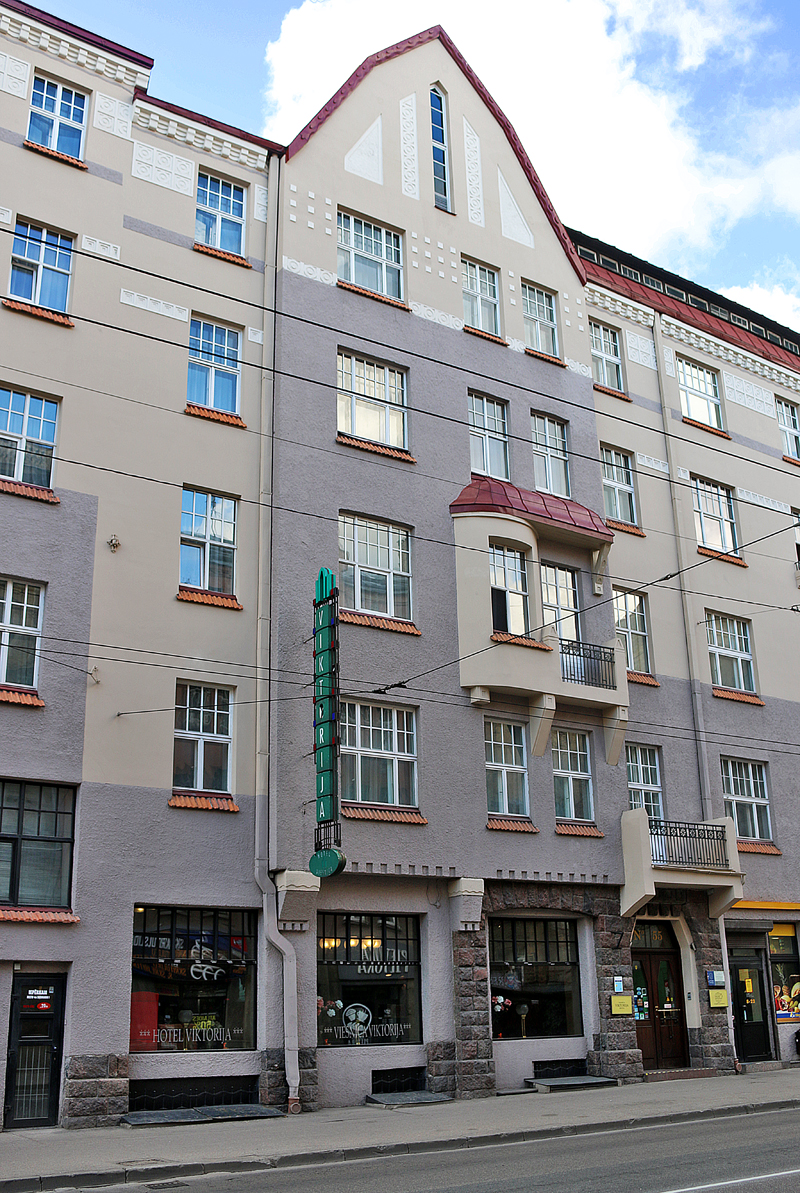
I eventually arrived at the Viktorija hotel, which is on the left side of Aleksandra Čaka ilea when walking northeast. This photograph is of the front of Hotel Viktorija.

On the edifice on the left side of the entrance to the hotel is this plaque…

…and above it is another plaque indicating that this is a three-star hotel property — one of the first hotels in Latvia to receive this distinction since the country became an independent republic.

The sign below that of the large one indicating the name of the hotel property has seen better days.

This photograph is of the view of Aleksandra Čaka ilea across the street from the hotel, facing southwest towards the central train station not long before dusk.

Upon entering inside of the hotel into the vestibule, visitors must turn left through the double doors with windows in them to access the eclectic reception area — the lamp is one clue — to check into the hotel.
I walked up to the desk to find a man who seemed like he was barely in his early twenties, with his head down as though he was reading. A moment passed before he looked up, startled that I was there.
He greeted me in a friendly manner and checked me in as a guest; but he also lamented that he had to work on Easter Sunday. I sympathized with him, expressing to him that I hoped that he either was getting paid more or will have a day off coming up while everyone else is working, as I always enjoy those types of days off. He smiled and thanked me, taking it in stride by saying that it really was not a big deal.

The lobby itself — with its walls painted in gold — is across from the reception desk.

Many aspects of this hotel — including the lobby — seemed almost unchanged from the 1920s or 1930s.

On the side of the lobby farthest from the entrance is a bar where drinks can be ordered. Usually, the person at the reception desk doubles as the bartender.

Between the elevators and the bar were two artificial trees decorated with Easter eggs, as I was a guest at this hotel in April.

The elevators were excruciatingly slow — even with only five floors in the entire hotel property.

When I finally arrived at the fourth floor, I saw a couch and an artificial tree.
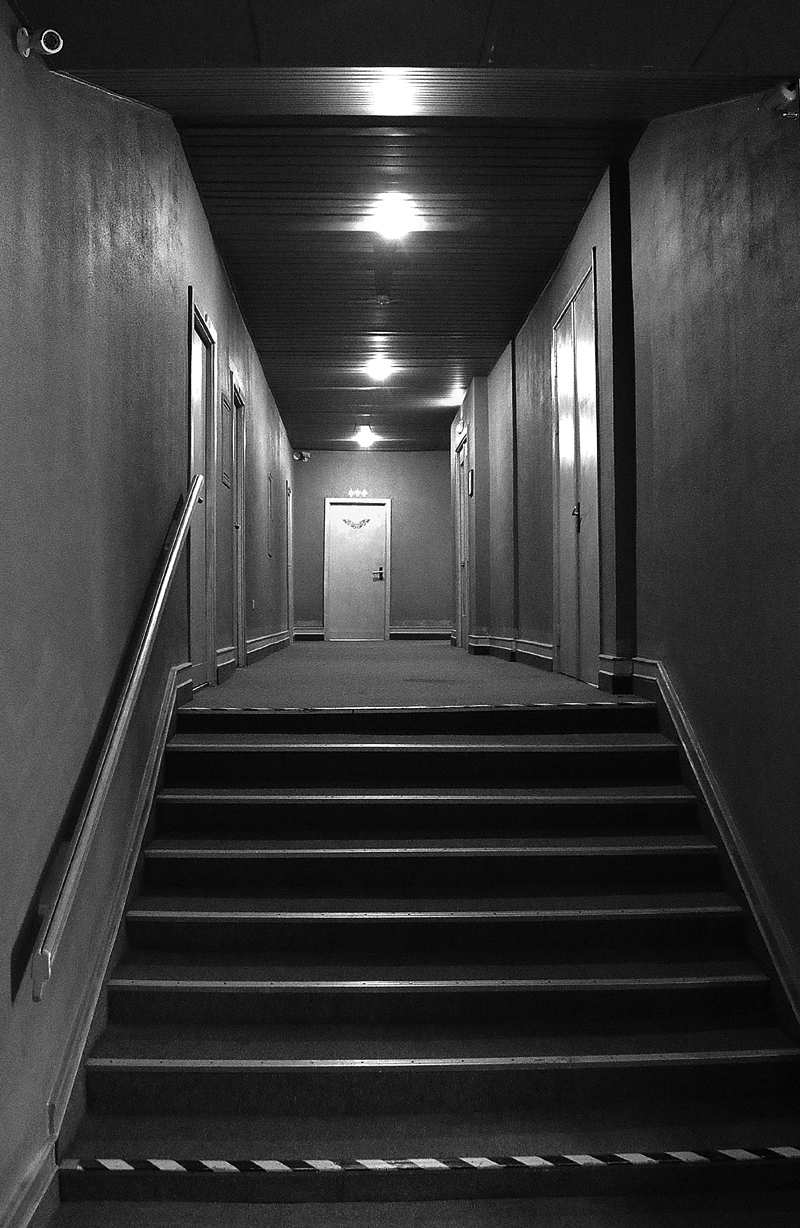
I then walked down the hallway to find my room. The stairs indicated to me that the hallway is connected by what apparently was two separate buildings at one time.

The ceilings in some of the hallways show signs of neglect, as indicated by the water stains and missing tiles — but what appeared to be closed-circuit security cameras indicate some semblance of security.

This is an example of how the doors looked in this part of the hotel property — but the aesthetics of the hallway were not consistent, depending on which part of the building you were in.

For example, this hallway is in another section of the hotel. The floor of this hallway was comprised of hardwood instead of carpet; and although it looked nice, the hardwood floor was creaky and felt unusually hollow — for lack of a better description — below me whenever I walked.

I finally arrived at my room, which looked like it was in a part of the building that was either newer or renovated more recently. The door on the left in the photograph on the left is the entrance to my room; and the photograph on the right is the view from the door to the room. A staircase is located on the other side of that door; and a different section of the hotel is beyond that area.
The Room

Two twin beds — which were not all that comfortable — were separated by a small night table with a lamp on it. One set of towels — a hand towel and a bath towel — awaited me on the bed on the right.

These are the curtains — which match the linens — of antique cars to which I originally alluded in this article.

At the foot of one of the beds is a chair with a desk; and on the desk was a telephone; two glasses upside down on a plate; a box of tissues; and a guide to the hotel property.
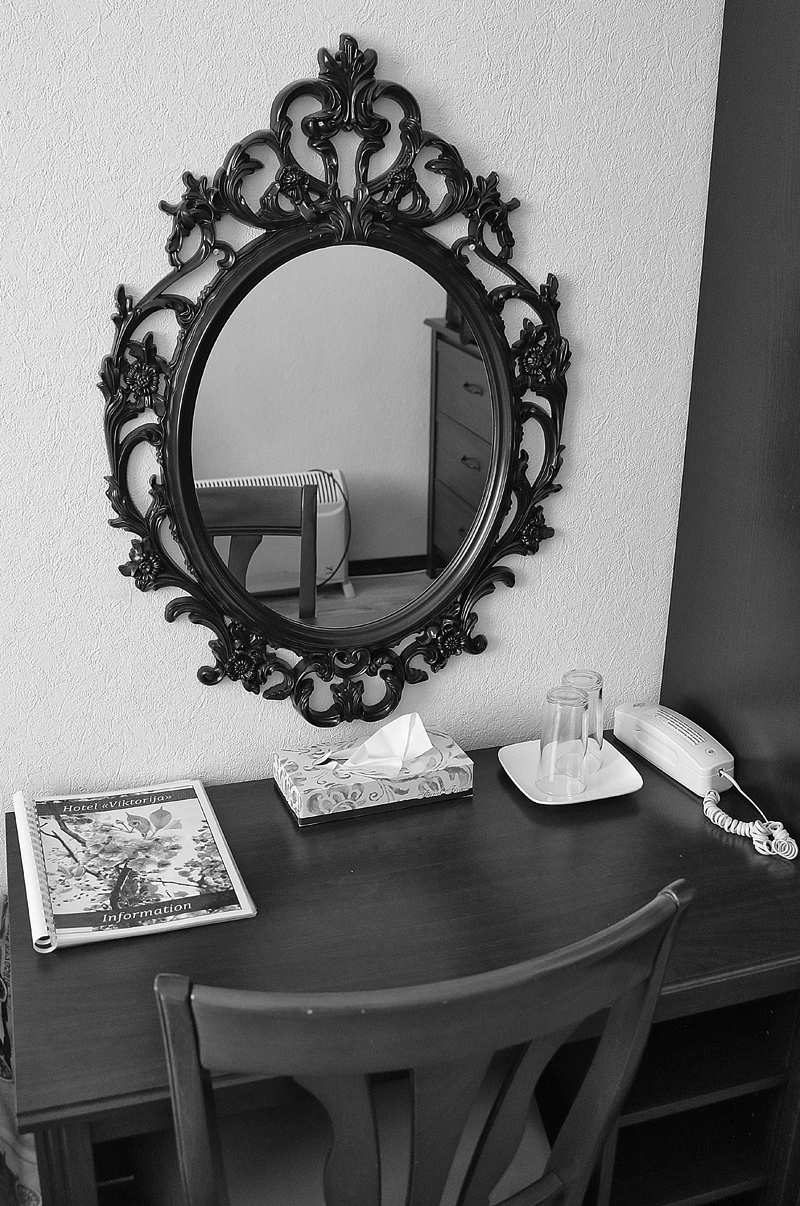
Above the desk was a mirror. Remove the telephone; and this photograph could look like it was taken in the 1930s.
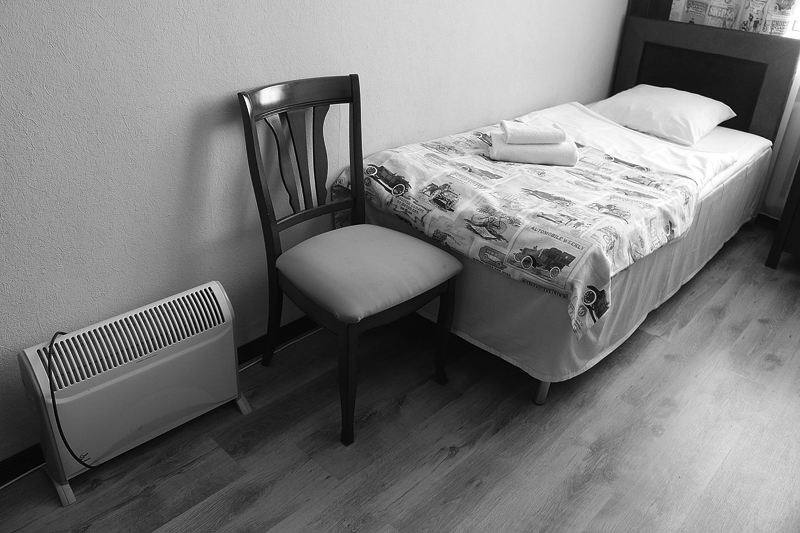
At the foot of the other bed was another chair and a portable electric heater.

I am not sure what this photograph is supposed to represent; but it hung on the wall above the portable electric heater.

This view from the twin beds shows that the room is equipped with a small flat-screen television; a miniature refrigerator; a chest of three drawers; and a full-length mirror. The room was definitely an odd shape.

The photograph on the left shows the exit to the hallway on the left; an area for hanging clothes in the center; the door to the bathroom on the right; and the aforementioned full-length mirror. A closer view of the area for hanging clothes is shown on the right, which included amenities which I did not expect — such as slippers wrapped in cellophane similar to what one would find in a more expensive hotel…

…as well as two sealed packets of moist cloths to shine shoes; a sewing kit; and a plastic shoehorn. I was surprisingly impressed with the unexpected offering of amenities.

This light fixture hung from the ceiling above the feet of the beds…
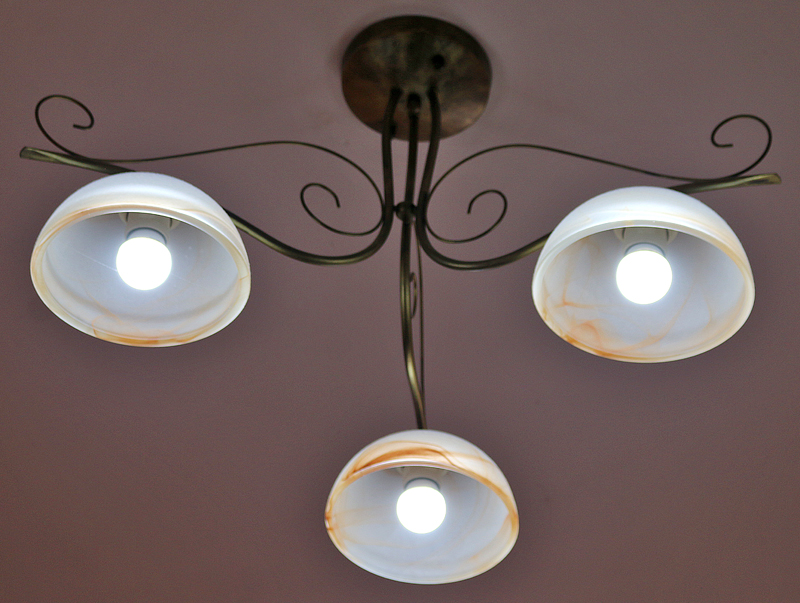
…and this is what the light fixture looked like when switched on.

I liked the wooden room indicator to which the key to the room was attached.

Interestingly, the only way to lock the door once inside of the room is by using the key — which is manufactured today would probably not meet modern standards for fire safety.

Speaking of fire safety, this map shows the evacuation plan for the hotel — as well as the configuration of the fourth floor of the hotel. The room to which I was assigned was room 436, as shown in the top right part of the evacuation plan.
The Bathroom

The bathroom was rather small; but it was basic and functional. Liquid soap is provided in dispensers in both the shower area — along with a dispenser for shampoo — as well as on the left side of the sink. A hair dryer hangs on the wall on the left side of the sink; and a hook is attached to the wall to hang a towel.

Cracked tiles and moldy caulk were found along the floor of the shower area — as well as other areas of the bathroom near the floor.

Toilet paper is concealed in a dispenser next to the toilet. Although that is somewhat unusual for a hotel room, it does protect the toilet paper from the — ahem — unwanted moisture or other artifacts from previous guests.
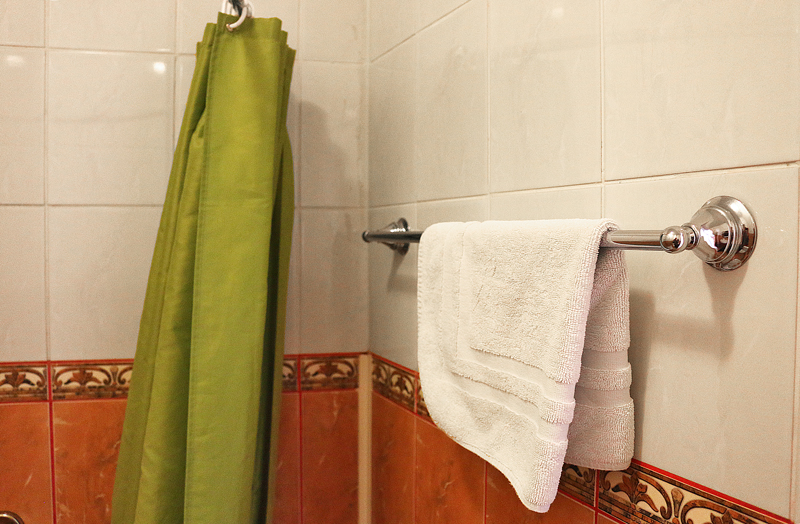
A towel for the floor to dry wet feet hangs on a rack near the shower area.
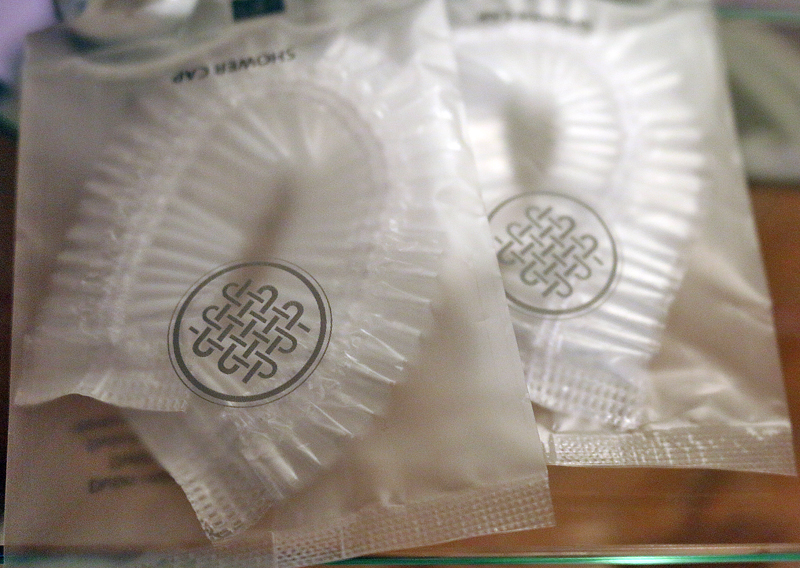
Two shower caps were sealed in their own packaging on a glass shelf under the mirror above the sink.
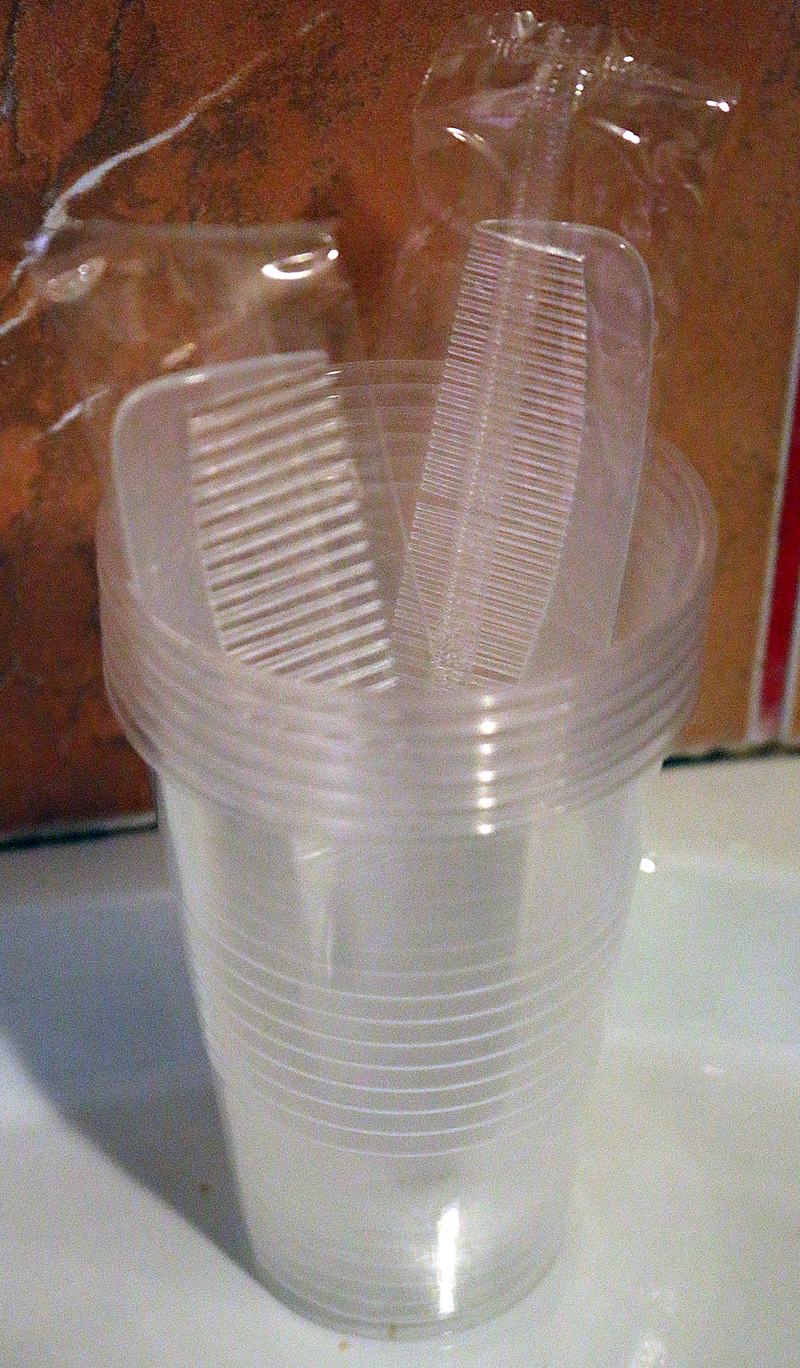
Two plastic combs were sealed in cellophane and stored in no fewer than six plastic cups on the right side of the sink.
The View

I looked out of the lone window in the room to see the view, which was not great — but I would not call it the worst view from a hotel room which I have ever seen.
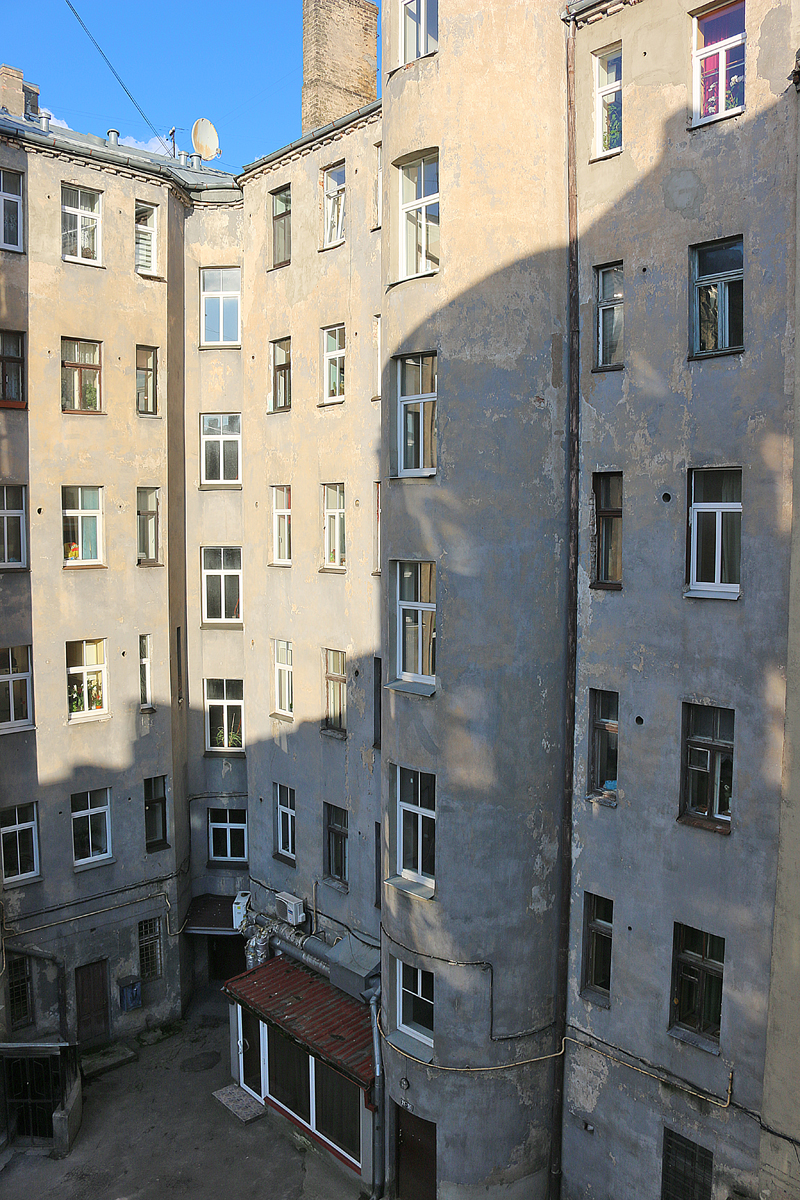
It was a courtyard which was completely surrounded by buildings.

I was not sure if these buildings contained hotel rooms or apartments.

The courtyard was completely paved…

…and apparently accessible for cars to be parked.

One trash receptacle was on the verge of being overfilled…

….when someone decided to add unwanted refuse to the other trash receptacle.

A closer look at one of the buildings reveals duct work which has seen better days — despite the layers of duct tape.

The flag of Latvia waved proudly on a flagpole in the courtyard.
The Stairs

Because the elevators were so slow, I would up using the stairs for the remainder of my stay.
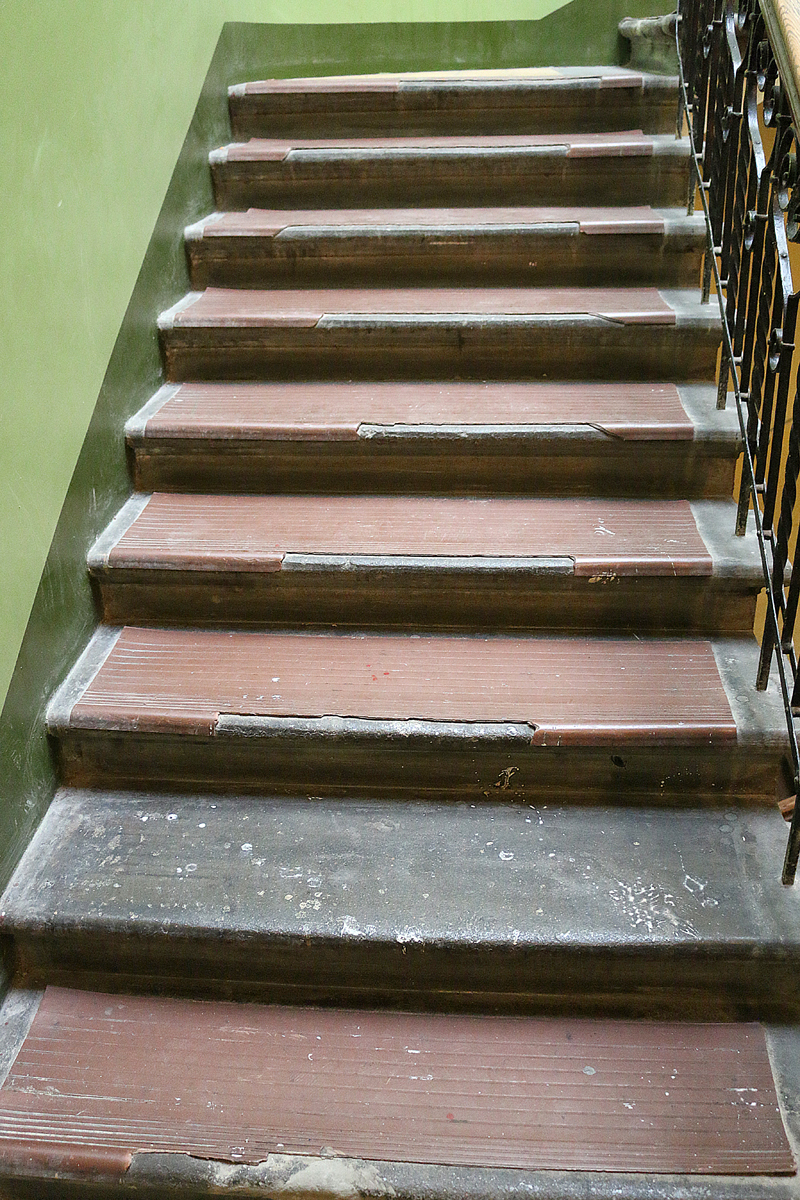
For some reason, I found myself captivated by the most minute details of the stairs…
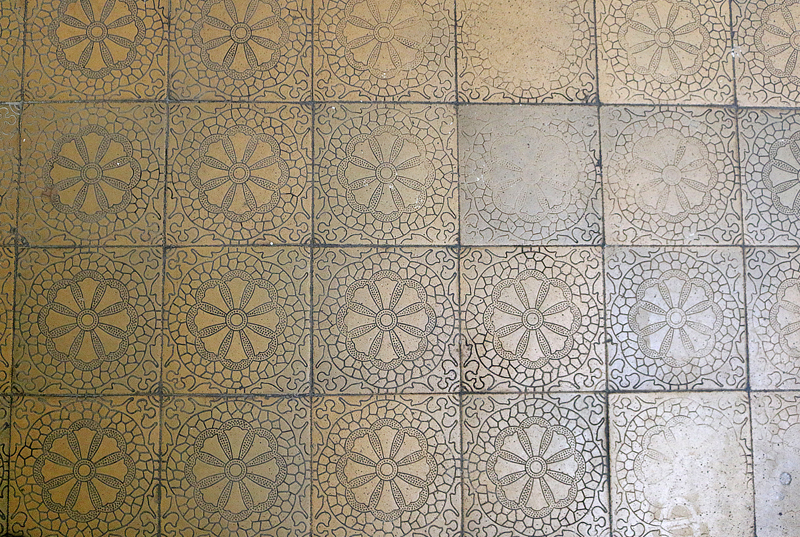
…even down to the details of the tiles on the floors at the edges of the stairs…
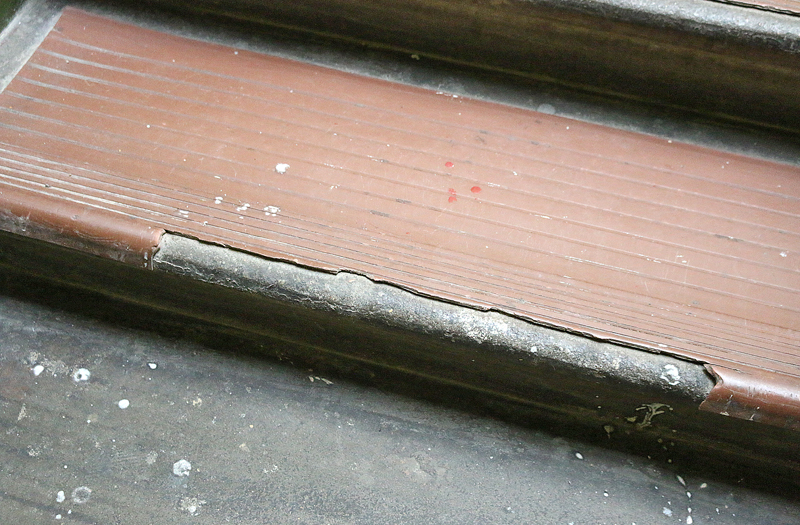
…as well as the defects, signs of neglect, and wear and tear over the years.

The building which houses the hotel was constructed in 1910 and designed by Janis Asaris, who was an architect in the Art Nouveau style.
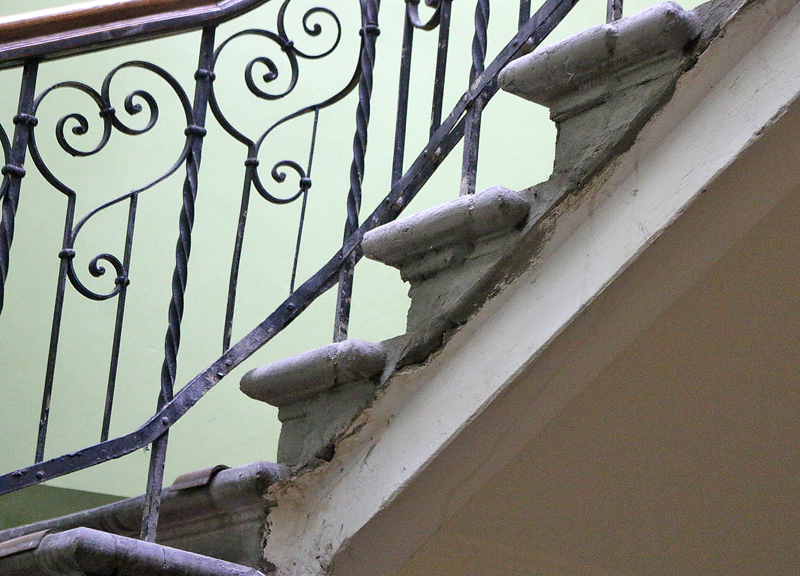
The textures on the staircase mesmerized me for some inexplicable reason.

Hotel Viktorija was included on the Junesco list of protected historical monuments.

In 1993, Hotel Viktorija was recognized as the first private hotel property after Latvia achieved independence from the Soviet Union on Wednesday, August 21, 1991…

…something which I did not know about this hotel property when I booked my reservation to stay here for one night.

2009 was supposedly the last year when Hotel VIktorija was redesigned when a different company began to manage the hotel.

Exits and fire safety equipment are clearly visible along the staircase.

One of the two staircases was closed to access; and the sign hanging from the chain warns that the space is alarmed.
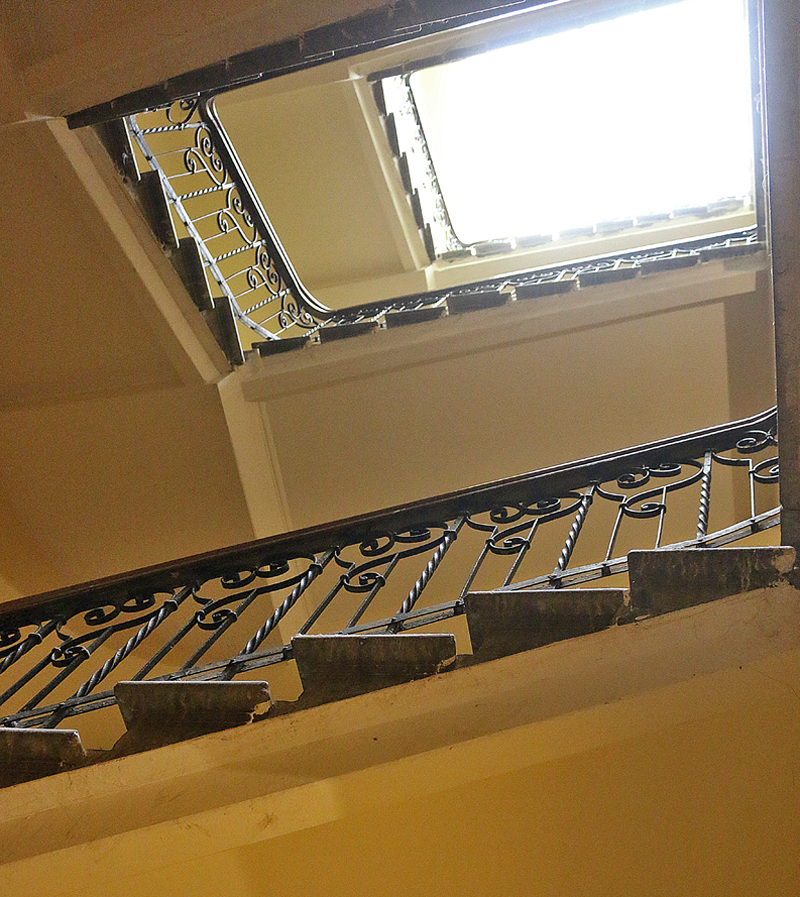
A skylight bathes the otherwise dark staircase with natural light.
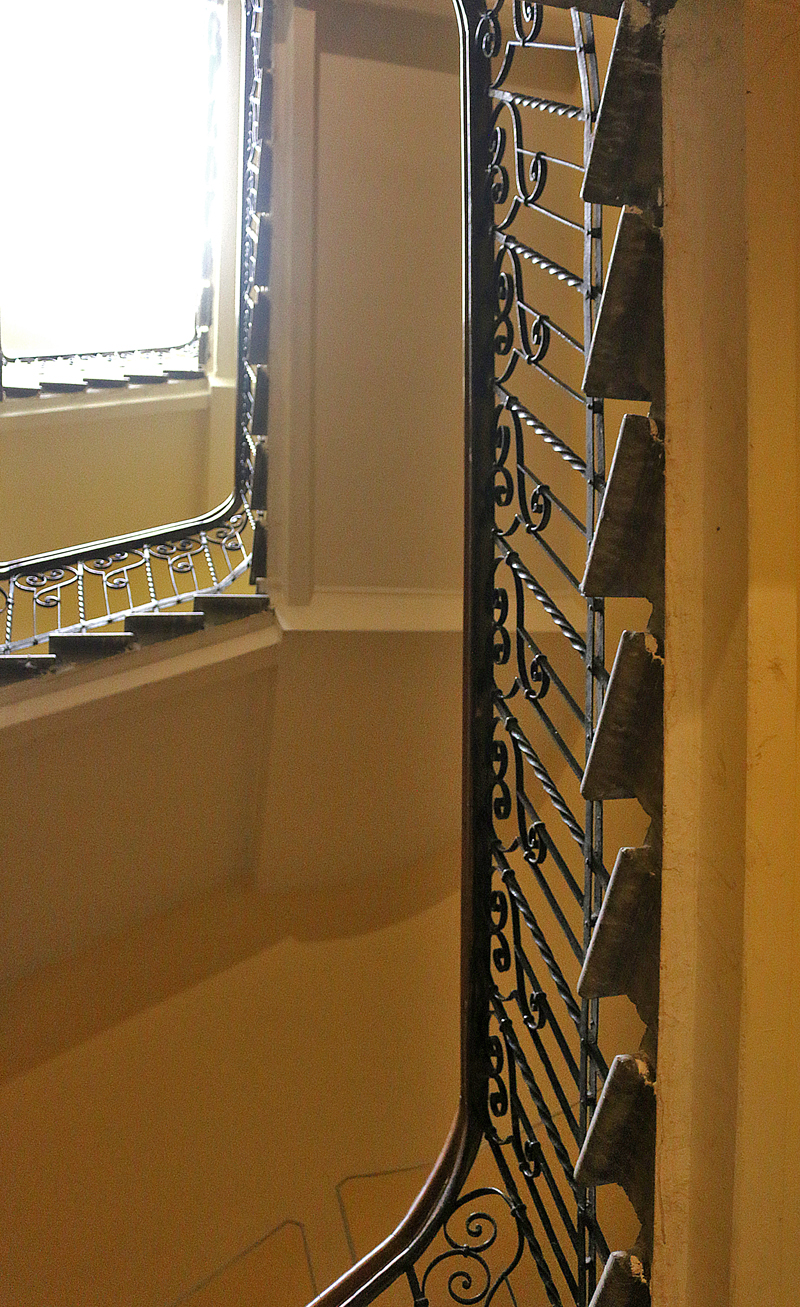
Wrought iron supports the wooden rail which snakes around as it follows the staircase.
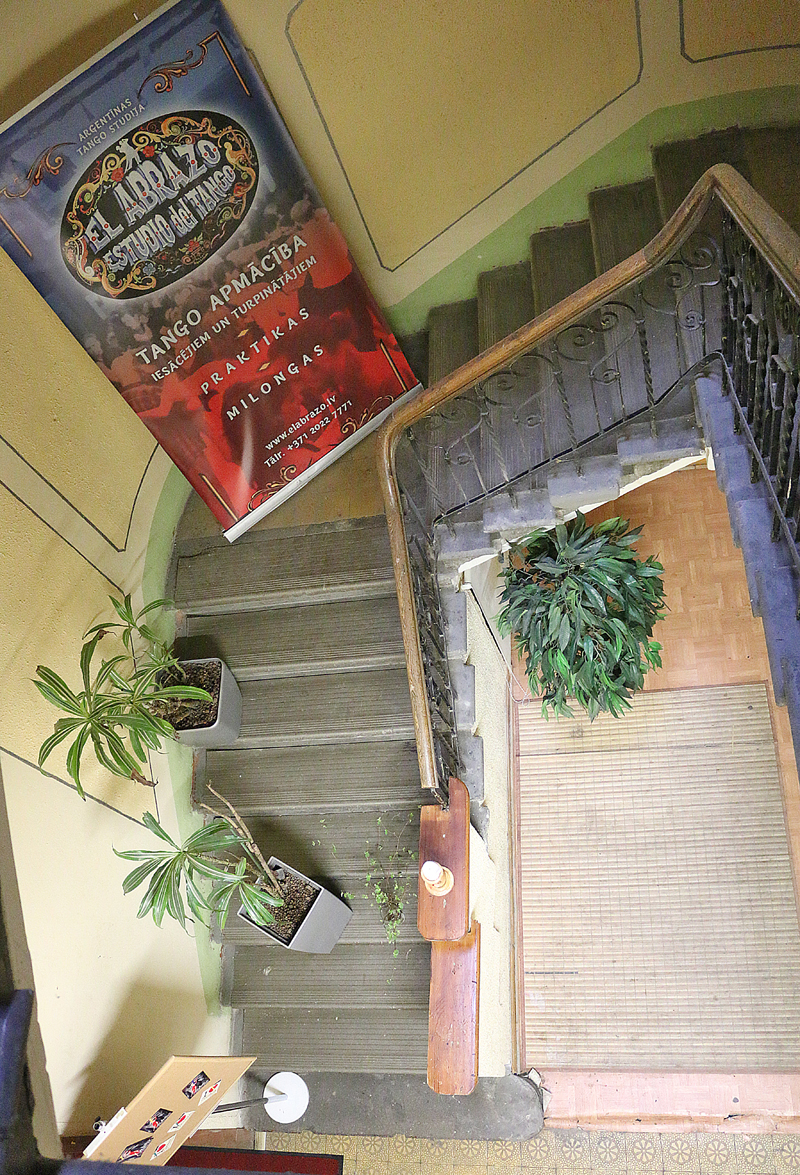
The bottom of the closed staircase is used as a storage area for plants; a sign; and a decorative banner.

Using the staircase was significantly faster — up or down — than using the elevator.

The steps on this portion of the staircase seem to be in better shape than others elsewhere on the staircase.

I am not sure what a lone glove was doing in one of the stairwells on an otherwise interesting radiator, which would probably look even better if it was not coated with what appeared to be so many layers of paint.

Breakfast

After I woke up the next morning, I walked downstairs to the Viktorija Kafejnīca — which simply translates into the word café in Latvian — as breakfast was included with my room rate. Guests do not need to leave the building in order to enter the Viktorija Kafejnīca.

Walking in from the entrance, I expected to see meager offerings of what I would consider to be generally inedible fare for breakfast; but once again, I was pleasantly surprised to see the selection of food and beverages which awaited me.

Still water, apple juice, orange juice and multifruit nectar were amongst the cold beverages offered…

…as well as milk — and hot beverages included coffee, hot water and assorted varieties of tea.

A metal “basket” of apples and bananas, assorted cookies, jams and jellies and honey were available…

…and next to that was a dispenser for cereal.

Guests had a choice of sliced bread and what seemed to be oatmeal or some sort of hot cereal.

Sign me up for pickles, black olives, green olives, pickled mushrooms, and corn…

…as well as sliced cucumbers and tomatoes for breakfast.

I passed on the assorted cold meats and cheeses.

Small individual containers of assorted yogurt, hard boiled brown eggs, what appeared to be kippers or sardines, and ketchup and mayonnaise were amongst the food items displayed on the counter.

Two distinct areas were separated by the breakfast buffet — both of which were spartan but somewhat cozy. This dining area is located across from the counter of food near the entrance of the Viktorija Kafejnīca…

…while this dining area was accessible through an open door beyond the counter by the cold beverages. I sat in this dining area to eat my breakfast.
After Check Out
A woman who was in her twenties — dressed in a floral top, short skirt, and pumps — was behind the reception desk and did the check out process for me. In a short conversation, she told me that she was originally from Russia.
Because I was not leaving for Vilnius in Lithuania until later that evening, I asked if I could please have my bag stored so that I could wander around Riga. “Of course”, she said; and she had me follow her to a dark short hallway behind the bar to a locked room. She opened the door; and I placed my bag on one of the shelves.
When I returned to the hotel property a couple of hours before I was scheduled to leave Riga to retrieve my bag, I asked her if I could access the Internet. She gave me a code; and I was able to work on my laptop computer.
I had no issues with the speed of accessing the Internet — regardless of whether I was in my room or in the lobby.
Final Boarding Call
“Sure, you will find offerings from such companies as Carlson, Choice, Best Western and AccorHotels — as well as Pullman and NB — but you are out of luck if you had your heart set on any of the offerings of Hilton, Hyatt, Marriott, Starwood or InterContinental Hotels Group, as none of those companies currently have any properties located in Riga” is what I wrote when this article was first published exactly eight years ago. However, you will find more options from multinational lodging companies in Riga in 2025 than back in 2017 if you would rather not stay at Hotel Viktorija.
I do not know if any repairs or renovations have occurred since I was a guest at this hotel property.
If you can walk 1.2 kilometers from the central train station of Riga to Hotel Viktorija, then do not bother researching any other transportation option. No hills or other impediments will lengthen the walk of only 16 minutes — except for crossing Satekles iela, which is the main wide thoroughfare outside of the train station and heavily trafficked. The hotel property is also a convenient walk to the central market, the river, and the Old Town area of Riga, as I walked everywhere and never used any other mode of transportation — even in the falling graupel.
Because of a sale by Orbitz with a last-minute deal of a discount of 27 percent, I had enough Orbucks to pay for the hotel — $20.94, which was reduced by $7.74 from $28.68 — basically rendering my stay as free of charge, as I did not have to pay a single penny…
…so for what I “paid”, I really was not expecting much from staying as a guest at Hotel Viktorija — based on my experiences at such places as Katse Lodge in Lesotho; MozGuest Residence in Mozambique; and the Sentrim Boulevard Hotel in Kenya, which were all decent stays. My expectations were low — and my experience at Hotel Viktorija exceeded some of those expectations.
Even at $28.68 in total, I would recommend staying at this hotel property despite having mixed feelings about it. I was never denied service; and the employees were friendly and accommodating enough — and they spoke English, which was a plus for me. Breakfast was quite sufficient — some hotel properties would charge a ridiculous $21.00 alone for a similar breakfast — and while not exactly considered luxurious, the room was reasonably comfortable…
…but signs of neglect and needed repairs and refurbishing were clearly evident: stains from water leaks, cracked tiles, moldy caulk, and other items which I normally would turn me off to a hotel property — but despite all of that, I thankfully saw no signs of vermin of any kind.
Parking for cars is available for seven euros — in 2017, the cost was five euros. Costs to park other vehicles are detailed here.
To my surprise, the hotel offered spa services not far from the room in which I stayed. Those services were available at an extra cost — such as a massage with a choice of aromatic oils for 90 minutes at a cost of 35 euros.
I could not help but think that Hotel Viktorija has so much potential to be a classic hotel property. Perhaps one day that will happen — but if so, do not expect the low rates to continue to be available. In fact, room rates seem to have at least doubled since I stayed as a guest…
Hotel Viktorija
55 Aleksandra Čaka ilea
Riga, LV-1011
Latvia
+371-67014111 24 hour telephone number
+371-67014140 Fax
info@hotelviktorija.lv E-mail address
All photographs ©2017 by Brian Cohen.

